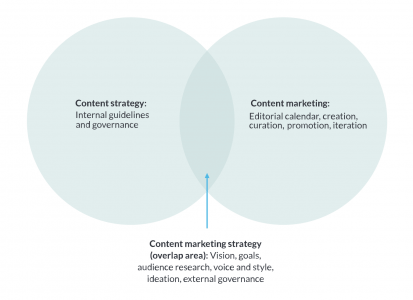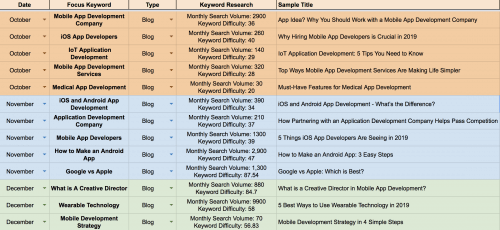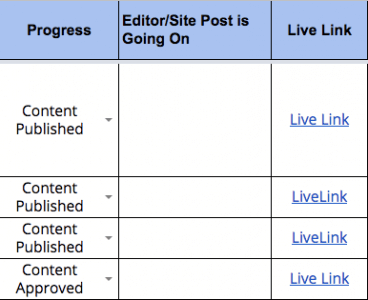You’ve done your research.
You performed the audits.
But have you established a strategy for your content marketing? Search engine optimized content is one of the main drivers of organic growth for websites and its the key to generating tens of thousands of dollars in site traffic through the expert use of content.
But, you’re not going to generate this kind of traffic unless you have a strategy. Content is good, thin content is bad. Google has already told us that thin content is negative for your site, so YES you should be creating content, but you shouldn’t be creating without strategizing.
This article will be dedicated to defining what content marketing is and how to make your content into something that actually accomplishes something.
What is a Content Marketing Strategy?
Content Marketing Strategy is the formulation of goals and the creation of internal guidelines that dictate the way your team creates content while providing a calendar for the team to follow in the creation of that content. To give an example, its a lot like fishing. You need to find the right location, the right target, and the right approach based on your desired results.
For example, you aren’t going to fish for swordfish the same way you’d fish for catfish, and you definitely wouldn’t be sitting in a muddy lake hoping to spot that prized swordfish. Fishing is about knowing where the fish are, knowing what fish eat, and knowing what fish don’t want.
Similarly, if your content is not designed to appeal to a target audience, is published on the wrong channel, and/or doesn’t provide the right kind of information it will fail.
The difficulty in content marketing is that, unlike fishing, it’s a little harder to get a definitive understanding of your target audience. Each person is unique in some way, while sharing similarities. Surprisingly, a large majority of companies don’t really understand who their audience is, or what their audience really wants.
According to Moz, “A content marketing strategy is the culmination of two very important aspects of content creation; Content Strategy & Content Marketing.”
“Vision without execution is hallucination.” Thomas Edison
So what can Agencies learn from this Venn diagram?
- Understand your audience (or your client’s audience).
- Establish internal rules and guidelines to regulate content creation.
- Establish a release schedule for your content and build on a firm foundation.
All of these are essential as they assure that the resulting content succeeds in carving out space for you or your clients as “Thought Leaders” in the chosen industry. Maintaining the client’s voice ensures that their content is unique and their own. Keeping the content creation on schedule provides constant opportunities for growth. Finally, a solid foundation i.e. social media, branding, and research gives the content the best chance to succeed.
You don’t want to waste time or money on a strategy that will fall flat and turn into thin content.
How to Begin your Content Strategy
The Basics
Now that we have defined what a content marketing strategy is, it’s time to go over how to set up a winning strategy. As with other strategies, a few of the core components are very similar. Such as:
- Create a Goal
- Identify an Audience
The goal of a content marketing strategy should be to grow both organic traffic and ranking keywords. These two metrics have been shown to have a correlation. More ranking keywords equates to increased visibility which in turn leads to increased traffic.
Keywords
Organic Sessions
As you can see from the images above, both organic sessions and organic keywords rose hand in hand. As keywords increased the number of sessions triggered on the site rose substantially over a 5 month period.
Results like this can be obtained if the content is geared towards an audience that will be receptive to its message. Hubspot speaks to the importance of identifying an audience by saying, “[with] knowing your target audience, you can produce more relevant and valuable content that they’ll want to read and convert on. You can set your target audience by identifying your top verticals according to sales numbers, examining who the competition is trying to connect with, and/or by expanding to a new audience that had previously not been considered.
The Details
Now that we have the basics covered, it is time to get to the nitty-gritty details of creating a content marketing strategy (for details into our persona research-based content marketing strategy). Let’s get right to it, there are three additional components to creating a successful strategy that ensures it goes off without a hitch.
- Determine the keywords that will be targetted by conducting thorough keyword research.
- Identifying the ‘Type’ of Content
- Assembling a Content Calendar
If you’re wondering what it looks like to create a calendar, this screenshot is from a company-wide google sheet. It targets everything we need for keeping our content on track to target something specific, to use a specific author, contain a post data, and we’ve even included a section for a downloadable offer.
Keyword Research
The backbone of content, keyword research is what makes or breaks a content piece. Without a focus keyword in mind, the content serves no purpose other than just to exist. As such, research needs to be conducted in order to find out which keywords have volume and how difficult it would be to rank for said keyword.
Tons of tools exist for keyword research, but for this post, I’ll show Raven Tools and Moz. Both of these tools have shown to have accurate monthly traffic numbers and they are great tools for finding keywords that will, (going back to the fishing analogy) “cast the widest net.”
Raven Tools
This screenshot taken on Raven’s Keyword Research Central shows the available metrics that can help you decide if a keyword is worth pursuing. From here you can then go on to identify keyword search volume, identify relevant keywords and then add them to Keyword Manager to organize your SEO campaign by adding tags & discover ranking & traffic via Search Console. But, while Raven Tools is great for finding keyword volume, it doesn’t have a keyword’s ranking difficulty rating. If you’re wanting to see some insights into difficulty, we can open up Moz.
Moz
When looking at a keyword in Moz, it is best practice to make sure it’s difficulty is lower or within 5 of your Domain Authority (DA). Domain Authority is a metric created by Moz that measure the credibility of your site in the eyes of Google. DA grows with more links pointing to your site. To read up on the importance of backlinks check out this article from webconfs.com.
The final thing you should look at for keyword research purposes is the Search Engine Results Page (SERP) itself. When it comes down to it, this is just one of the many research elements for SEO.
This is known as a Share of SERP Analysis and this can truly determine if your content will rank or not. Essentially, if the top ranking pages/sites have far higher DAs then your own, you need to either find a long-tail keyword variant or choose a new one entirely. You don’t want to be caught up in a losing battle. Or if the currently existing content on the SERP is just better (videos, better design, highly informative, original images, etc) then you either need to upgrade your content or start improving drastically. We recommend reading over the Raven SEO Campaign Guide and combining your content marketing strategy with proper implementation of your overall SEO Campaign.
Important note: Domain authority is a metric created by Moz and it does its best at guessing Google’s Page Rank. It is not 100% accurate but it is meant to give a ballpark figure. You don’t always need the highest DA to rank for a keyword. Many factors exist for determining whether you will rank. I’ve seen low DA sites with a singular focus (such as business consulting) outrank high DA sites because Google sees the lower DA site as having a favorible E-A-T score within the keyword niche. If you’re wondering what E-A-T is (or if you want additional information on what Google uses to determine what will rank, then I recommend you read Google’s Search Quality Evaluator Guidelines.
One last thing on this topic, the most recent “medic” update has further implemented these guidelines as ranking factors. Authority is established in a myriad of ways. Relevant backlinks, social mentions, and a body of work that testifies to your expertise on a subject (one of the reasons the Hub and Spoke strategy or Pillar Strategy is frequently used in establishing more authority).
Choosing the Content ‘Type’
A fully fleshed out content marketing strategy won’t just include blog posts. On top of blogs, your strategy should include: infographics, e-books, case studies, and guest posts just to name a few. Having various forms of content makes your messaging more diverse and potentially more appealing to audiences who favor a visual approach. Here are some examples!
On top of being visually appealing, different forms of content can be utilized for demand generation by making them ‘Gated Content.’ By placing “gates” in the shape of form fills, you can increase the number of warm leads generated by your content.
Content can also be used to acquire backlinks! This is where Guest Posting comes in. Guest Posting is done by identifying other websites in your industry and finding contacts that you can outreach to with the goal of writing content for them. The point of this tactic is to write content in exchange for a backlink which diversifies your link portfolio while providing a free piece of content to whoever receives the content.
Assemble a Content Calendar
Your content marketing strategy is now almost ready to go. You’ve done the keyword research and have various forms of content being designed, but you still need a concise way to check in and make sure everything stays on schedule. A content calendar makes all of this easy.
A good content calendar, like the one pictured above, provides keyword researched topics and a working title along with a rough date for release. Having the keyword research included adds additional insight as to why the topics are being added. This is helpful when pitching new topics to a client/content manager as it shows that they are backed by data. It is also a ‘living’ document which then leaves room for new pieces of non-blog content to be added as necessary.
It is also smart to include a ‘Progress’ & ‘Link’ column which ensures that anyone viewing the calendar can understand what is being created, drafted, and published.
With these best practices in mind, your content calendar will be fully fleshed out and able to track the progress of your content marketing strategy.
Closing Thoughts
There may be a lot that goes into creating and executing a content marketing strategy, but if you are serious about increasing organic traffic it is a necessary process. If you take anything away from this piece let it be this, keep your eye on the goal and remember to always follow the keyword research.

Analyze over 20 different technical SEO issues and create to-do lists for your team while sending error reports to your client.













